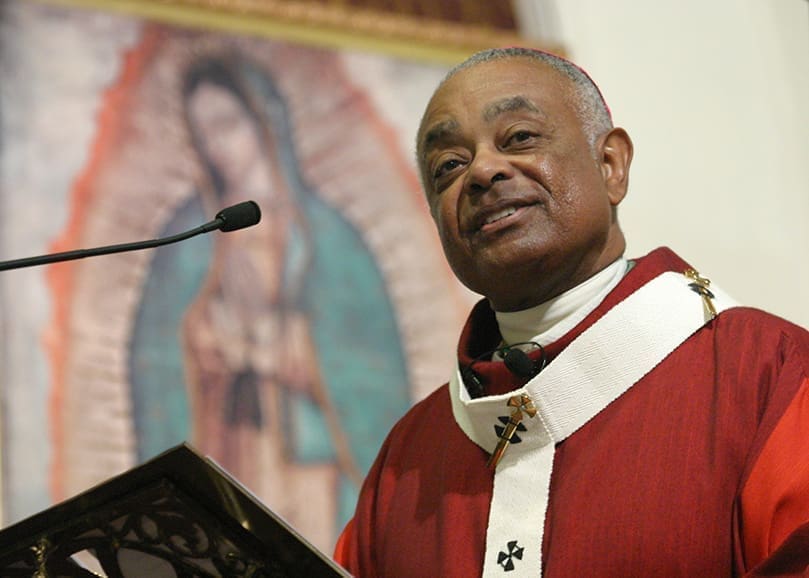 Photo By Michael Alexander
Photo By Michael AlexanderAtlanta
Archbishop Gregory Answers Questions About Mary
By ANDREW NELSON, Staff Writer | Published September 27, 2012
The Catholic Church has announced plans to commemorate a Year of Faith worldwide, led by Pope Benedict XVI, beginning Oct. 11. In the Atlanta Archdiocese, Archbishop Wilton D. Gregory, who had already planned a Marian focus for the year, decided to join the two together—Mary and faith—to focus on “the image and example of Mary.”
Archbishop Gregory explained more about this special attention to the Mother of God in a recent question-and-answer dialogue with The Georgia Bulletin.
The year is known simply as the Year of Faith. Why did you choose to adopt a Marian focus for the year for the Atlanta Archdiocese?
My staff and I had decided about two years ago to focus this year on the image and example of Mary—under her many different titles that are identified with so many of the different communities that comprise the Archdiocese of Atlanta. She serves as a blessed foundation of unity for this great community, and her various titles should serve to draw us together in faith. When the Holy Father more recently designated this year as a Year of Faith—in commemoration of the 50th anniversary of the Second Vatican Council, I didn’t feel that we necessarily had to abandon our prior plans to focus on the Blessed Mother because she herself is the very personification of faith. It seemed reasonable to combine the themes into a single point of focus on that Woman of Faith who inspires us as her children—identifying with so many various peoples but always as their mother.
What does Mary represent for you?
She is the Mother who identifies herself with her children in each age, nation and in every culture. She is first and foremost, Mother—and like every Mother she is pivotal in the development of faith in the lives of her children.
How can Mary serve as a role model for women and men in the 21st century?
She stands out as a woman who listened and responded positively to God’s voice at a moment in time when things looked pretty dismal for the children of Israel. The Romans were an oppressive force in the lives of the Jewish people and the issue of religious liberty for the Jews was largely dependent upon the largesse of the ruling authority. This young woman of faith was unafraid to take a risk in doing what God invited her to do and to become a central part of God’s plan of salvation.
What are you most looking forward to as the Year of Faith gets underway?
I hope and pray that it will be a time when Catholics will rediscover the gift of faith, the gift of the profound spiritual dimensions of our ethnic and cultural identities and the cherished relationships with the Mother of God and with one another through her.
Do you have a particular devotion to one of the varied cultural expressions of Our Lady? How did the devotion come about? What has it meant to you through the years?
I must admit that I do not have a particular devotion that outranks all of the others. During my time in the Archdiocese of Chicago, I was very fortunate to experience the religious devotional life that many different cultures had in honoring the Mother of God. I can recall with great delight the festivities of the Polish community, the Croatian community, the Mexican community, the Lithuanian, the Italian community, the French community—all of them with special feasts and joyous celebrations that honored Mary. Since arriving here in the Archdiocese of Atlanta, I have rejoiced with the Cuban community, the Vietnamese community, and I still recall with great admiration the singing of the women from the Cameroon community as they attributed the ordination of our first Cameroon priest to the direct intercession of the Mother of God—“Mary did it for us!” In each situation the children of Mary recall that she has become one with them, taking on their appearance, their language, their attire—she follows her Son’s pattern of becoming incarnate within the human family. They all bring joy to my heart.
And since it is also the anniversary of Vatican Council II, has the Church’s understanding of Mary changed or deepened because of the council documents?
The Second Vatican Council placed heavy significant attention on Christology—the theology of Christ as God and Man and Redeemer and ecclesiology—the theology of the Church. Mariology is always a branch of Christology since she is the bridge that allows God to become Man. Because of the council our understanding of Mary was focused through Christ and she became the model and the mother of the Church as the first person of faith. While some older customs might have considered her apart from the Church and Christ in their theological understanding, Mary was placed in her proper place of honor by the council as the Mother of the Word made flesh and the very image of the Church in its perfection.
What are three goals you hope the people of the Archdiocese gain from the year?
I long for a deeper appreciation of our union in Christ because of the attention and the importance of the Mother of God. As we focus on a number of Marian titles during the course of this year, I hope we rediscover our union in Christ because His Mother has become our Mother. I hope that we rediscover a spirit of evangelical outreach as Mary has continually sought to welcome every culture and nation into the embrace of her Son’s Church. I hope that we can renew our gratitude for the gift that the Second Vatican Council was for the entire Church as it stands at the very heart of 20th-century Catholicism.